Friday, November 30, 2007
New Arizona policy choices report defines why sustainability matters for Arizona
The first report of its kind, Sustainability for Arizona is a primer on the subject as well as a targeted analysis for Arizona. In addition to thoughtful examinations of the state’s history, economy, environment, and society, Sustainability for Arizona presents the views of 24 leading policy thinkers in Arizona and across the country including Bruce Babbitt, former U.S. Secretary of State; Brad Casper, CEO of Dial Corporation; Allen Affeldt, owner of La Posada Hotel and Mayor of Winslow; and Mandy Roberts Metzger, Flagstaff-area rancher and president of Diablo Trust. With essays from civic leaders, ranchers, developers, educators, business leaders, scholars, and others, the topics span a range and include water resources, education, historic preservation, innovation, health care, green building, and urban planning to present unique perspectives on sustainability’s implications for Arizona. [Note: To read the full article, click here.]
Sedona's Hart Store achieves National Register of Historic Places listing
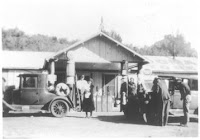 [Source: Sedona.biz] -- The City of Sedona’s Historic Preservation (HP) Commission is excited to announce that the Hart Store has been named to the National Register of Historic Places. This is only the second property in Sedona to be listed on the National Register. The first to be listed was the Walter and Ruth Jordan farmstead in Jordan Historical Park, home to the Sedona Heritage Museum. The state’s Historic Site Review Committee approved that the Hart Store, Sedona’s first store, be listed on the state register in July. They then forwarded their recommendation to the ‘Keeper’ in Washington D.C. The City HP Commission and the property owner were notified last week of this honor. The Hart Store is the oldest intact commercial building in Sedona.
[Source: Sedona.biz] -- The City of Sedona’s Historic Preservation (HP) Commission is excited to announce that the Hart Store has been named to the National Register of Historic Places. This is only the second property in Sedona to be listed on the National Register. The first to be listed was the Walter and Ruth Jordan farmstead in Jordan Historical Park, home to the Sedona Heritage Museum. The state’s Historic Site Review Committee approved that the Hart Store, Sedona’s first store, be listed on the state register in July. They then forwarded their recommendation to the ‘Keeper’ in Washington D.C. The City HP Commission and the property owner were notified last week of this honor. The Hart Store is the oldest intact commercial building in Sedona. Located at the intersection of Brewer and Ranger roads, the Hart Store was part of Sedona’s original commercial center. It was built for L.E. ‘Dad’ Hart in 1926. As Sedona’s first and only store in the 1920s-30s, Hart ran a general store and gas station. When public electricity came to town, the store was the first private building to hook-up after ‘Dad’ Hart helped get the line installed. After the main road was re-routed to today’s ‘Y’ in 1939, the store was remodeled into a duplex and was used for residential purposes until Annemarie Hunter and Jac Robson purchased and restored it. It is now a store again and home to the ‘Hummingbird House’ which features art, home decor and gifts. The historic Hart Store was designated a Sedona Historic Landmark in 2002 and Annemarie and Jac’s extensive repair and restoration was honored by KSB in 2003 with an award for ‘exemplary renovation and use of a historic property.’ [Note: To read the full article, click here.]
Florence has two Legacy Projects in state's centennial celebration
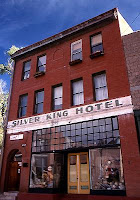 [Source: Bonnie Bariola, Florence Reminder] -- The "Rehabilitation of the Florence/Silver King Hotel" and the "Florence Memorial Cemetery Park" have been designated as official Arizona Centennial Legacy Projects by the Arizona Historical Advisory Commission (AHAC). In the fall of 2004, Governor Janet Napolitano, Senate President Ken Bennett and House Speaker Jake Flake jointly announced their preference for the Arizona Historical Advisory Commission to plan the state's centennial. Established by the legislature in 1976, the AHAC is the only statewide commission dedicated to Arizona history representing major state history and heritage institutions. As a result, the responsibility of planning for Arizona's centennial was added to AHAC's responsibility.
[Source: Bonnie Bariola, Florence Reminder] -- The "Rehabilitation of the Florence/Silver King Hotel" and the "Florence Memorial Cemetery Park" have been designated as official Arizona Centennial Legacy Projects by the Arizona Historical Advisory Commission (AHAC). In the fall of 2004, Governor Janet Napolitano, Senate President Ken Bennett and House Speaker Jake Flake jointly announced their preference for the Arizona Historical Advisory Commission to plan the state's centennial. Established by the legislature in 1976, the AHAC is the only statewide commission dedicated to Arizona history representing major state history and heritage institutions. As a result, the responsibility of planning for Arizona's centennial was added to AHAC's responsibility.As chair of the AHAC, State Historic Preservation Officer Jim Garrison became chair of Arizona's Centennial Planning Committee. The Commission developed as its vision for the centennial "To ensure a lasting legacy for future generations by encouraging all Arizonans to reflect on our unique and authentic history, to experience the rich and diverse tapestry of our heritage, and to explore our promising future." The Commission's Centennial Mission is: Develop, encourage, and coordinate a statewide plan for Arizona's centennial in 2012 including:
- Advising the Legislature and state agencies on centennial history and heritage, arts, and culture
- Assisting the governor's countdown to the centennial to support school children learning about Arizona's history
- Recommending and funding activities and projects that will ensure lasting legacy accomplishments to commemorate the centennial
The two projects submitted by Florence were selected after careful review by the AHAC. Arizona Centennial Legacy Projects must 1) accurately portray a significant aspect of Arizona history; 2) be accessible to a large number of visitors/users; 3) demonstrate collaboration in the planning; 4) produce an enduring product that will live on after 2012; 5) include an educational component; and 6) include a plan for implementation. [Note: To read the full article, click here.]
UA looks at restoring historic 1906 Douglass house
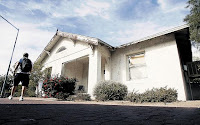 [Source: Eric Swedlund, Daily Star] -- The Douglass House, a turn-of-the-century home once owned by the UA's first academic superstar, has long attracted the attention of preservationists on campus and is now an administration priority for restoration. "There is very significant and sincere interest in restoring the building," said Albert Tarcola, director of facilities management. "It's on my list as No. 1 to be restored." Finished in 1906, the Douglass House, also known as the Cannon/Douglass House, was the second building on the north side of Speedway, following the George E.P. Smith House, both of which are now listed on the National Register of Historic Places.
[Source: Eric Swedlund, Daily Star] -- The Douglass House, a turn-of-the-century home once owned by the UA's first academic superstar, has long attracted the attention of preservationists on campus and is now an administration priority for restoration. "There is very significant and sincere interest in restoring the building," said Albert Tarcola, director of facilities management. "It's on my list as No. 1 to be restored." Finished in 1906, the Douglass House, also known as the Cannon/Douglass House, was the second building on the north side of Speedway, following the George E.P. Smith House, both of which are now listed on the National Register of Historic Places. The house was originally owned by William A. Cannon, a botanist who sold it to A.E. Douglass in 1913. Douglass lived in the house until 1923. Douglass was a Harvard astronomer in 1894 when Percival Lowell recruited him to scout the Arizona Territory for the best observatory site. Douglass worked as Lowell's chief assistant at the Lowell Observatory outside Flagstaff before arriving in Tucson in 1906 to join the UA faculty. At the UA he became known as the father of dendrochronology, the science of tree-ring dating, and was the founder of the Steward Observatory. Restoration will give the university a better public face and promote the university as a good steward of public resources, said R. Brooks Jeffery, preservation-studies coordinator and associate dean of the College of Architecture and Landscape Architecture.
[Note: To read the full article, click here. Photo source: Greg Bryan, Daily Star.]
Wednesday, November 28, 2007
History Channel announces the launch of the Save Our History grant program
The History Channel is proud to support the preservation of local history across the country. To date, The History Channel has awarded over 1 million dollars to fund 109 preservation projects across the country. Click here to read descriptions of past Save Our History grant projects and to apply for a grant. The grant application will be posted in January 2008 and will be due Friday, June 6th, 2008. Funded projects can be implemented at any time during the 2008-2009 school year. Should you have any questions about the grant application or process, please email the Save Our History team.
Monday, November 26, 2007
Preservationists urged to submit session proposals for 2008 National Preservation Conference
 The National Trust for Historic Preservation invite you to submit proposals for Education Sessions or Poster Presentations for the 2008 National Preservation Conference in Tulsa, OK. The deadline for proposals is Friday, January 11. The Trust is particularly interested in proposals dealing with the following focus areas:
The National Trust for Historic Preservation invite you to submit proposals for Education Sessions or Poster Presentations for the 2008 National Preservation Conference in Tulsa, OK. The deadline for proposals is Friday, January 11. The Trust is particularly interested in proposals dealing with the following focus areas: - Green Building. Existing buildings contain embodied energy and other environmental advantages that are important in sustainable communities. What are models for combining green building and preservation? What potential synergies and issues should be addressed? How can both USGBC's LEED point system and preservation standards help realize these potentials?
- Recent Past and Modernism. Why are these resources important? What are the trends, challenges, and opportunities for attracting support for their preservation? What are successful community strategies and models to do this?
- Teardowns and McMansions in Older and Historic Neighborhoods. What are the pros and cons of teardowns? How does a neighborhood determine the vision for its future and craft and implement strategies to achieve that vision? What are the most effective models for neighborhood action when faced with teardowns?
- Urban Revitalization and Adaptive Use. What are the advantages and challenges of a preservation approach to urban revitalization? What strategies and models work best for mid-sized cities? For major urban areas?
- Rural Revitalization. How can preservation strategies gain broader support in rural economic development and farmland preservation programs? What innovative models involve using cultural heritage tourism to the economic benefit of rural areas?
- Historic House Museums. What current trends affect visitation at historic sites? What creative strategies can attract more visitors or identify alternative uses for historic sites?
- Historic Roads and Scenic Byways. What are we learning about ways to promote protection and continued use of historic roads like Route 66? What lessons can we learn from the growing support for scenic byways?
Submitting your proposal is easy and quick. Click here for Education Session and Poster Presentations. Questions? Contact Charlotte D. Bonini, PhD, Senior Education Planner for the Center for Preservation Leadership, by phone 202-588-6095 or email.
State preservationist to talk at the University of New Mexico
Camp Naco preservation continues forward march, makes APF's endangered list
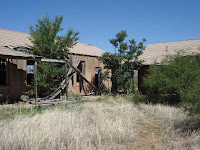 [Source: Ted Morris, Herald/Review] -- Thousands of American troops swarmed here long ago, a response to border friction of a different era. A visible reminder of that turbulent 1911-1923 timeframe — the stucco-walled barracks and officers quarters of Camp Naco — has been placed on the Arizona Preservation Foundation’s 2007 Most Endangered Historic Places list. “All of the properties we have named are important historic landmarks in Arizona, but unfortunately are in grave danger of collapse, demolition, or destruction,” said Vince Murray, president of the Arizona Preservation Foundation board. “It is critical that residents and government officials act now to save these elements of their cultural heritage before it’s too late.” The foundation’s mission is to preserve Arizona’s historical, archaeological, architectural and cultural assets. “Compiled by preservation professionals and historians, the list identifies critically endangered cultural resources of major historical significance to the state,” says the foundation’s Web site.
[Source: Ted Morris, Herald/Review] -- Thousands of American troops swarmed here long ago, a response to border friction of a different era. A visible reminder of that turbulent 1911-1923 timeframe — the stucco-walled barracks and officers quarters of Camp Naco — has been placed on the Arizona Preservation Foundation’s 2007 Most Endangered Historic Places list. “All of the properties we have named are important historic landmarks in Arizona, but unfortunately are in grave danger of collapse, demolition, or destruction,” said Vince Murray, president of the Arizona Preservation Foundation board. “It is critical that residents and government officials act now to save these elements of their cultural heritage before it’s too late.” The foundation’s mission is to preserve Arizona’s historical, archaeological, architectural and cultural assets. “Compiled by preservation professionals and historians, the list identifies critically endangered cultural resources of major historical significance to the state,” says the foundation’s Web site. The endangered-list designation is one of a series of positive developments this year as a broad-based community group has rallied to save the deteriorating buildings that once formed an American stronghold on the U.S.-Mexico border. The community was galvanized by an arson fire that gutted some of the noncommissioned officers quarters on May 21, 2006. Leaders from Huachuca City, Cochise College, University of Arizona South, Turquoise Valley Golf Course, Naco Fire Department and other community organizations formed the Camp Naco Arizona Preservation Committee, or CNAPC. In April, the Center for Desert Archeology in Tucson, led by Bill Doelle, sponsored CNAPC in securing a $17,500 grant from the Southwest Foundation for Education and Historic Preservation to initiate preservation work. In May, more than 50 volunteers participated in a cleanup day at the camp. Most of those helpers were students from Fort Huachuca’s Basic Officer Leadership Course.
In June, the town of Huachuca City was awarded an $80,169 Arizona Heritage Preservation Fund grant written by CNAPC. That grant would provide muscle for intial preservation steps: a building condition assessment, ongoing site cleanup and a nomination to the National Register of Historic Places. Perhaps most critical, the Heritage Preservation Fund grant provided about $17,800 toward 2,200 feet of security fencing that Stan’s Fence Co. of Whetstone will soon install around the historic site. The Huachuca City Town Council awarded the contract to Stan’s on Nov. 8. In October, “Initial asbestos abatement by Environmental Strategies Inc. of Tucson was completed around the two camp barracks quadrangles, clearing the way for the building condition assessment,” said local historian Debby Swartzwelder, a member of the Camp Naco Arizona Preservation Committee.
[Note: To read the full article, click here. Photo source: Ted Morris, Herald/Review.]
Yavapai Nation offers cultural tour of tribal lands
 [Source: Lynn Ducey, Phoenix Business Journal] -- The Fort McDowell Yavapai Nation is offering a cultural heritage tour through tribal lands. Called "The Yavapai Experience," the tour is being offered through one of the nation's commercial ventures, Fort McDowell Adventures. As part of the tour, a professional guide acts as a facilitator between guests and tribal members. Visitors gather around a campfire to hear stories about the tribe's ancient culture, history and heritage from tribal members who were born and raised on the ancestral land of the Fort McDowell Yavapai Nation.
[Source: Lynn Ducey, Phoenix Business Journal] -- The Fort McDowell Yavapai Nation is offering a cultural heritage tour through tribal lands. Called "The Yavapai Experience," the tour is being offered through one of the nation's commercial ventures, Fort McDowell Adventures. As part of the tour, a professional guide acts as a facilitator between guests and tribal members. Visitors gather around a campfire to hear stories about the tribe's ancient culture, history and heritage from tribal members who were born and raised on the ancestral land of the Fort McDowell Yavapai Nation. The tour also includes a guided one-mile nature trail walk that depicts how the Yavapai are connected to the Sonoran desert. Visitors can sample authentic Yavapai food with dishes including cabbage stew and fry bread, and the tour also includes a question-and-answer session to help visitors learn more about the nation. The Fort McDowell Yavapai is one of three Yavapai tribes in Arizona. The nation has lived in central Arizona for thousands of years and in 1903 was granted a 25,000-acre reservation 35 miles northeast of Phoenix. The tour is available for groups of four or more. Costs vary.
Scottsdale named a Preserve America community
 [Source: City of Scottsdale] -- First Lady Laura Bush has notified Scottsdale that the city has been accepted as a Preserve America community, recognizing its historic preservation efforts. “President Bush and I applaud your achievement,” Mrs. Bush wrote in her notification letter. “As your community shares its story with residents and visitors, you set a great example for others.” Preserve America is an Administration initiative that encourages and supports community efforts to preserve and enjoy the nation’s cultural and natural heritage. The goals of the initiative include a greater shared knowledge about the nation’s past, strengthened regional identities and local pride, increased local participation in preserving the country’s cultural and natural heritage assets, and support for the economic vitality of our communities. Mrs. Bush is the honorary chair.
[Source: City of Scottsdale] -- First Lady Laura Bush has notified Scottsdale that the city has been accepted as a Preserve America community, recognizing its historic preservation efforts. “President Bush and I applaud your achievement,” Mrs. Bush wrote in her notification letter. “As your community shares its story with residents and visitors, you set a great example for others.” Preserve America is an Administration initiative that encourages and supports community efforts to preserve and enjoy the nation’s cultural and natural heritage. The goals of the initiative include a greater shared knowledge about the nation’s past, strengthened regional identities and local pride, increased local participation in preserving the country’s cultural and natural heritage assets, and support for the economic vitality of our communities. Mrs. Bush is the honorary chair.“This is an important designation for Scottsdale,” said Mayor Mary Manross. “It confirms the community’s commitment to honor our past and the special character that has made Scottsdale such a quality community.” Scottsdale was recognized for the city’s demonstrated commitment to historic preservation and support for heritage tourism activities through a partnership with the Scottsdale Convention and Visitors Bureau. The designation also means Scottsdale is eligible to apply for funding for a range of projects, including tourism, promotion and preservation activities. [Note: To read the full letter from Mrs. Bush, click here.]
Sunday, November 25, 2007
Park Service heritage areas catching on
 [Source: Ben Evans, Associated Press] -- Every region of the country has its own piece of Americana that locals brag about to visitors. Increasingly, they are asking Congress to help spread the word through a little-known federal program that designates National Heritage Areas. After approving just two dozen such areas since the early 1980s, Congress adopted 10 last year. The House signed off on six more last month, and the wait list is growing. Illinois wants recognition for Abraham Lincoln's early stomping grounds; New York is bidding for the area around Niagara Falls (pictured). Alabama is pushing a region along the Tennessee River where the Tennessee Valley Authority was born and where "Father of the Blues" W.C. Handy first picked a guitar.
[Source: Ben Evans, Associated Press] -- Every region of the country has its own piece of Americana that locals brag about to visitors. Increasingly, they are asking Congress to help spread the word through a little-known federal program that designates National Heritage Areas. After approving just two dozen such areas since the early 1980s, Congress adopted 10 last year. The House signed off on six more last month, and the wait list is growing. Illinois wants recognition for Abraham Lincoln's early stomping grounds; New York is bidding for the area around Niagara Falls (pictured). Alabama is pushing a region along the Tennessee River where the Tennessee Valley Authority was born and where "Father of the Blues" W.C. Handy first picked a guitar.Yet for the first time, the program is facing resistance on Capitol Hill from budget hawks and property-rights advocates. The National Park Service has called for a freeze on new designations until lawmakers approve more formal guidelines for the program. "This is a relatively new model for conservation," said John Cosgrove, executive director of the Alliance of National Heritage Areas. "More and more community leaders want to apply it to their own regional stories." Modeled after European practices, heritage areas are billed as a cost-effective, locally driven alternative to government-managed historic sites. The government does not buy property, impose land restrictions or provide staff. In fact, the heritage program is expanding in part because little money is available for new publicly owned park facilities. Instead, grass-roots groups are encouraged to preserve geography and history within livable communities. A heritage designation comes with a federal grant of up to $1 million a year, to be matched with local money. The local groups have flexibility in managing the areas, and the 37 existing sites have taken various approaches since the first was named in 1984, designating a historic canal linking the Great Lakes and the Illinois River. [Note: To read the full article, click here.]
Friday, November 23, 2007
Fort Huachuca kicks-off holiday season with historical tour
Also, each home on the tour is named after an individual credited with being instrumental in the development of Fort Huachuca and the Army. Participants will also have the opportunity to enjoy live music, hot drinks and baked goods. Backpacks, strollers, cameras and other recording equipment will not be permitted. Children under 10 years old are not allowed to attend the tour. This yearly event is organized by the Fort Huachuca Community Spouse’ Club with all proceeds benefiting their scholarship program. Tickets may be purchased in advance for $8 at the Fort Huachuca Museum or $10 the day of the event.
Arizona treasures are worth the journey
 [Source: J.C. Martin, Daily Star] -- Some of the stunning beauty of Arizona is visible from major highways and national park drives — but many of the state's grandest scenic treasures are off the beaten track. A book called "The Back Roads" (Arizona Highways, $19.95), by Sam Negri, is a guide to some of the best slow-lane routes to splendid scenery. It features a rich array of photographs by some of the top contributors to Arizona Highways magazine. Some years ago, longtime Arizona journalist Negri, who is now an Arizona Daily Star editorial writer, put together a book for Arizona Highways called "Arizona: the Beauty of It All." "I drew on my personal experiences knocking around in obscure places," Negri says of that book, which divided the state into regions and described the natural and social characteristics of each of them.
[Source: J.C. Martin, Daily Star] -- Some of the stunning beauty of Arizona is visible from major highways and national park drives — but many of the state's grandest scenic treasures are off the beaten track. A book called "The Back Roads" (Arizona Highways, $19.95), by Sam Negri, is a guide to some of the best slow-lane routes to splendid scenery. It features a rich array of photographs by some of the top contributors to Arizona Highways magazine. Some years ago, longtime Arizona journalist Negri, who is now an Arizona Daily Star editorial writer, put together a book for Arizona Highways called "Arizona: the Beauty of It All." "I drew on my personal experiences knocking around in obscure places," Negri says of that book, which divided the state into regions and described the natural and social characteristics of each of them."Back Roads," Negri says, goes a step farther. It's a guide to 40 trips covering the whole state. If you didn't know the Bureau of Land Management is in the hot tub business, Drive 2 in the "Southeastern Arizona" section — covering a route from Safford to Fort Bowie National Historic Site — offers a look. If you would like to explore the Navajo Reservation, Drives 1, 2 and 3 in the "East of Flagstaff" section will guide you. Working with Arizona Highways editor Bob Albano, Negri has written text and combined short pieces by a handful of veteran Highways writers — including Tucson freelancer Leo Banks — to provide useful and informative copy for this compilation of back-road journeys. Each of the 40 drives comes with a reassuring "Route Finder." The Route Finder gets you to your destination and home again. That, says Negri, was a part of Albano's job. In an e-mail, Albano notes that he "drove each route and prepared the Route Finders with field-gathered information and maps. . . . Veteran back-road drivers know that there is no map that is 100 percent accurate for all roads and sites, and maps vary on the details for any given road or site. "But I'm confident," Albano adds jokingly, "that nine out of 10 travelers will find their way home with these directions." A suggestion: Travelers may want to take their cameras along to record specific experiences because the photographs, while gorgeous, are somewhat generic. [Photo source: Daily Star.]
Wednesday, November 21, 2007
Arizona Humanities Council seeks new executive director
 The Arizona Humanities Council (AHC), the Arizona affiliate of the National Endowment for the Humanities, is seeking an Executive Director to begin in early March 2008. The successful Executive Director will be an innovative and experienced leader who can strategically develop and manage all aspects of the Council, and build community consensus and partnerships under the shared vision set by the 24-member Board of Directors. AHC presently has a staff of seven, and an annual budget of $980,000 funded in part by the federal government, State of Arizona, and private and corporate donors. AHC is not a state agency; founded in 1973 the organization is an independent, nonprofit 501 (c)(3) corporation.
The Arizona Humanities Council (AHC), the Arizona affiliate of the National Endowment for the Humanities, is seeking an Executive Director to begin in early March 2008. The successful Executive Director will be an innovative and experienced leader who can strategically develop and manage all aspects of the Council, and build community consensus and partnerships under the shared vision set by the 24-member Board of Directors. AHC presently has a staff of seven, and an annual budget of $980,000 funded in part by the federal government, State of Arizona, and private and corporate donors. AHC is not a state agency; founded in 1973 the organization is an independent, nonprofit 501 (c)(3) corporation.AHC funds, directs, and supports public humanities programming throughout the state to promote public understanding and appreciation of the humanities. AHC awards grants to libraries, museums, and other nonprofits, and also directs its own activities such as the annual Arizona Book Festival, which attracts more than 8,000 people. The salary range for the Executive Director is $75,000 to $80,000, plus benefits. Additional information about AHC can be found on the web site.
Click here to download a PDF of a detailed description of the Executive Director duties and qualifications. Applicants wishing to be considered for the position must send a letter that outlines qualifications with resume or CV and contact information for three references to: Search Committee, The Ellis-Shackelford House, 1242 North Central Avenue, Phoenix AZ 85004-1887. First review of applications is December 10, and applications will be accepted until the position is filled.
Route 66 sociologists awarded federal grant
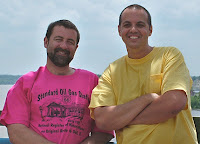 [Source: CCSU Courier] -- In recognition of their outstanding field work, Drs. John Mitrano (right) and Bruce Day (left) of the Central Connecticut State University Department of Sociology have been awarded a grant from the U.S. National Park Service Route 66 Preservation Program. The sociologists, who have led four CCSU student trips along Route 66 in the past five years, are leading scholars and teachers of Route 66 -- that quintessential highway of American culture. Under the grant, CCSU will administer the development of a Route 66 Curriculum and Activity Educator’s Resource Guide. The state-by-state curriculum for Route 66 can be used in a variety of disciplines (i.e., history, sociology, archeology, geography, community studies, urban development, etc.). In addition, this curriculum will be designed for use in the classroom and in the field while traveling on Route 66.
[Source: CCSU Courier] -- In recognition of their outstanding field work, Drs. John Mitrano (right) and Bruce Day (left) of the Central Connecticut State University Department of Sociology have been awarded a grant from the U.S. National Park Service Route 66 Preservation Program. The sociologists, who have led four CCSU student trips along Route 66 in the past five years, are leading scholars and teachers of Route 66 -- that quintessential highway of American culture. Under the grant, CCSU will administer the development of a Route 66 Curriculum and Activity Educator’s Resource Guide. The state-by-state curriculum for Route 66 can be used in a variety of disciplines (i.e., history, sociology, archeology, geography, community studies, urban development, etc.). In addition, this curriculum will be designed for use in the classroom and in the field while traveling on Route 66.“Each year we conduct this field study trip, we visit a combination of intriguing new sites and our old favorites,” states Dr. Mitrano. “We are constantly meeting new Route 66 enthusiasts, business proprietors, artists, preservationists, musicians, and authors along the way.” As part of the course, students conduct oral histories and interviews with such Route 66 individuals. To date, they have approximately 75 interviews tape recorded and are in the process of transcribing and indexing them. They will be made available for accessing by scholars and historians throughout the world. “A memorable moment is when we bring the students to spend the night in La Posada in Winslow, Arizona,” says Day. “This restored hotel was built to serve the earliest rail service into the American southwest and is a fascinating example of American history. Stepping into this building gives you the sense of turning back time.” [Note: To read the full article, click here. Photo source: CCSU Courier.]
Tuesday, November 20, 2007
Share your Arizona memories from the ‘70s with KAET
 [Source: KAET] -- Tell Us Your Arizona Memories. Were you there when the Phoenix Suns made the playoffs in their second season? Can you recall the very first Fiesta Bowl -- when ASU took the title? Were you watching when Mary Jo West made her debut as the first woman to anchor Phoenix prime-time news? Do you remember when the Tempe bridge was washed out in a flood? If you have memories of places and events during the 1970s, we may be able to include them in Eight’s next production "Arizona Memories from the ‘70s." Send an e-mail and share your memories.
[Source: KAET] -- Tell Us Your Arizona Memories. Were you there when the Phoenix Suns made the playoffs in their second season? Can you recall the very first Fiesta Bowl -- when ASU took the title? Were you watching when Mary Jo West made her debut as the first woman to anchor Phoenix prime-time news? Do you remember when the Tempe bridge was washed out in a flood? If you have memories of places and events during the 1970s, we may be able to include them in Eight’s next production "Arizona Memories from the ‘70s." Send an e-mail and share your memories.Let Channel Eight know about your Kodachrome slides, 8mm, Super 8mm, and 16mm home movies, photographs, or memoriabilia you have that evoke memories of places and events in Arizona, circa 1970s. Our production team will review the materials. If your story makes it to the final selection of topics, you will be hearing from us. So please fill out the form with complete contact information and submit by December 1st.
Community help needed to preserve Safford's historic Main Street theater
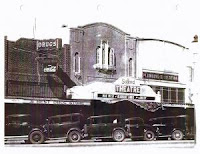 [Source: Jon Johnson, Eastern Arizona Courier] -- It’s been more than 30 years since the Safford Theater on Main Street closed its doors. Now an effort is under way to preserve the building and place it on the National Register of Historic Places. After being examined by the city of Safford, the building was deemed structurally unsound and beyond the city’s ability to restore. Planning and Zoning Director Pete Stasiak and Special Projects Manager Robert Porter previously reported to the Safford City Council that the building was not up to code and the east wall was in danger of falling at any time.
[Source: Jon Johnson, Eastern Arizona Courier] -- It’s been more than 30 years since the Safford Theater on Main Street closed its doors. Now an effort is under way to preserve the building and place it on the National Register of Historic Places. After being examined by the city of Safford, the building was deemed structurally unsound and beyond the city’s ability to restore. Planning and Zoning Director Pete Stasiak and Special Projects Manager Robert Porter previously reported to the Safford City Council that the building was not up to code and the east wall was in danger of falling at any time.The walls of the theater were built in the style of many other local historical buildings and are comprised of unreinforced masonry. The walls are as high as 35 feet and are made out of concrete bricks mortared together. Time has taken its tole by cracking the bricks and causing walls to be as much as a foot out of plumb. Faced with the disheartening news, owners David and Susan Duros are attempting to receive Heritage Fund grants from Arizona’s State Historic Preservation Office. Duros said the preservation office recommended she prepare a historic building preservation plan and apply for the National Register listing on their first grant application this December. If this grant is awarded, the theater will then most likely be able to receive a building stabilization grant in a subsequent grant cycle. [Note: To read the full article, click here. ]
Arborist says trees destroyed for Phoenix light rail could have been saved

[Source: Scott Wong, Arizona Republic] -- To some, palm trees are icons of Phoenix's historic landscape. Others see them as a public nuisance impeding the city's plans to remake downtown into a shady, walkable district linked by a light-rail line. Metro light rail's decision to destroy more than 300 palms in and around downtown has reignited the debate over whether the stately trees should continue to have a prominent place along Valley streetscapes. Tim Johnson, a top Arizona tree expert, was instrumental in helping Metro successfully relocate hundreds of palms, some of them historic, from along Central Avenue between McDowell and Camelback roads. Now, he says at least half of the 307 palms destroyed farther south to make way for the downtown light-rail segment known as Line Section 3 were healthy enough to be salvaged. [Note: To read the full article, click here.]
Monday, November 19, 2007
Plans call for bringing back original look of Florence's 'Old Main'
State Historic Preservation Officer Jim Garrison, and the SHPO Architect, Bob Frankeberger, have been meeting with the school officials to provide their advice in this project. They will assist in maintaining both the interior and exterior historical integrity of the building. The history of the building will be incorporated into the rehabilitation process, making this history available to the public. Art Celaya and John Swearengin are providing much of this historical information. Both are graduates of Florence High School. John graduated in 1938 and Art graduated in 1945. In addition, Art spent 36 years working for the school district as a teacher, coach, counselor, high school principal and finally superintendent for 16 years. This building was listed as one of the "Twelve Most Endangered Properties in Arizona" by the Arizona Preservation Foundation in 1999. After waiting eight years, funding is at last in place for this rehabilitation project. A 2000 Historic Preservation Heritage Fund Grant assisted in installing a new roof to stop further water damage. [Note: To read the full article, click here.]
ADA accolades for Casa Grande Ruins
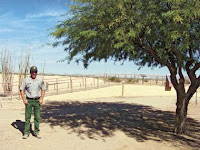 [Source: Brian Ahnmark, Casa Grande Valley Newspaper] -- In less than four years, Casa Grande Ruins National Monument has undergone a transformation. Gone are the days of 1930s infrastructure, a time before the implementation of accessibility standards. In its place: restrooms, walkways and viewing platforms designed to comply with the Americans with Disabilities Act - and enhance the visitor experience for all park guests. Larry Stewart, facility manager, has been the driving force behind the monument's push for ADA compliance since 2004. On Nov. 1, the National Parks Service honored Stewart as winner of the 2007 Accessibility Achievement Award.
[Source: Brian Ahnmark, Casa Grande Valley Newspaper] -- In less than four years, Casa Grande Ruins National Monument has undergone a transformation. Gone are the days of 1930s infrastructure, a time before the implementation of accessibility standards. In its place: restrooms, walkways and viewing platforms designed to comply with the Americans with Disabilities Act - and enhance the visitor experience for all park guests. Larry Stewart, facility manager, has been the driving force behind the monument's push for ADA compliance since 2004. On Nov. 1, the National Parks Service honored Stewart as winner of the 2007 Accessibility Achievement Award. NPS also recognized five parks, one service center, two other individuals, and one friends group. Each of the winners received a plaque presented by Deputy Director Dan Wenk during a ceremony at the Main Interior Building in Washington, D.C. The Accessibility Achievement Award program, initiated in 1998, recognizes "outstanding accomplishments by parks, partners, or employees that result in greater opportunities for persons with disabilities." Stewart was honored "for initiating upgrades on park infrastructure to meet universal accessibility standards."
[Note: To read the full article, click here. Photo source: Casa Grande Valley Newspaper.]
Mesa Historical Museum and Mesa High collaborate for 8th Annual Historic Home Tour
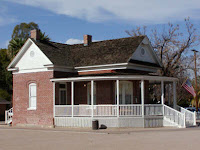 [Source: Kaia Landon, Mesa Historical Museum] -- The Mesa Historical Museum is excited to be collaborating with Mesa High School students on its 8th Annual Historic Home Tour. This year’s tour will be in the West Second Street Historic District, and will showcase 9 private homes in addition to a variety of historic buildings, such as the Sirrine House, Antique Wedding House, and the Irving School. Mesa High School students are helping by researching the buildings to be on the tour, drawing architectural diagrams including floor plans and elevations, and building scale models of the houses, which will be presented to the homeowners. The students are part of an architecture class under the direction of Mr. Bob Chambers, Industrial Technology Teacher at Mesa High School. The students will further contribute to the Historic Home Tour by serving as hosts and hostesses in the houses they research, helping the homeowners direct visitors and answer questions.
[Source: Kaia Landon, Mesa Historical Museum] -- The Mesa Historical Museum is excited to be collaborating with Mesa High School students on its 8th Annual Historic Home Tour. This year’s tour will be in the West Second Street Historic District, and will showcase 9 private homes in addition to a variety of historic buildings, such as the Sirrine House, Antique Wedding House, and the Irving School. Mesa High School students are helping by researching the buildings to be on the tour, drawing architectural diagrams including floor plans and elevations, and building scale models of the houses, which will be presented to the homeowners. The students are part of an architecture class under the direction of Mr. Bob Chambers, Industrial Technology Teacher at Mesa High School. The students will further contribute to the Historic Home Tour by serving as hosts and hostesses in the houses they research, helping the homeowners direct visitors and answer questions. As part of the tour, the Mesa Historical Museum produces an information-packed book, which is given to all tour participants. The book includes information on the styles of homes included, and the individual histories of the homes. Tickets are available now at the Mesa Historical Museum (2345 N. Horne, north of McKellips, and West Second Street Historic District) and online, and make great holiday gifts. Tickets are only $25/person, and include visits to more than a dozen historic buildings, complimentary lunch at RigaTony’s, a visit to the Mesa Historical Museum, and dessert. All proceeds benefit the museum. The home tour is Saturday, January 26 from 9 a.m. to 4 p.m. For more information, contact Lisa Anderson by email or phone at 480-835-7358.
Lots to do in Bisbee next weekend
 [Source: Carrie Ord, Daily Star] -- Bisbee will be a hub of activities next weekend, including a light show, holiday arts and crafts fair, historic home tour and a charitable silent auction. On Friday, the 36th annual Festival of Lights will have a live Nativity, Santa, live entertainment and tree and street lighting. Activities start at 6 p.m. in front of the Copper Queen Library, 6 Main St. Admission is free. On Saturday and next Sunday, the annual Historic Home Tour features docents in period clothing leading tours from 10 a.m. to 4 p.m. Saturday and noon to 4 p.m. next Sunday. Tickets cost $10 in advance, $12 the day of the tour. During the home tour, the "Chairs of Bisbee" will be on display for the annual Arts Chairs of Bisbee Silent Auction from 10 a.m. to 4 p.m. Saturday and noon to 4 p.m. next Sunday. The auction is sponsored by the Bisbee Woman's Club, and proceeds go to a local charity. For more information, call 1-866-224-7233 or visit Discover Bisbee. [Photo source: Elizabeth Mitchell.]
[Source: Carrie Ord, Daily Star] -- Bisbee will be a hub of activities next weekend, including a light show, holiday arts and crafts fair, historic home tour and a charitable silent auction. On Friday, the 36th annual Festival of Lights will have a live Nativity, Santa, live entertainment and tree and street lighting. Activities start at 6 p.m. in front of the Copper Queen Library, 6 Main St. Admission is free. On Saturday and next Sunday, the annual Historic Home Tour features docents in period clothing leading tours from 10 a.m. to 4 p.m. Saturday and noon to 4 p.m. next Sunday. Tickets cost $10 in advance, $12 the day of the tour. During the home tour, the "Chairs of Bisbee" will be on display for the annual Arts Chairs of Bisbee Silent Auction from 10 a.m. to 4 p.m. Saturday and noon to 4 p.m. next Sunday. The auction is sponsored by the Bisbee Woman's Club, and proceeds go to a local charity. For more information, call 1-866-224-7233 or visit Discover Bisbee. [Photo source: Elizabeth Mitchell.]
Friday, November 16, 2007
Call for papers & presentations for 2008 Southwest Oral History Association Annual Meeting
The program committee invites proposals from oral history practitioners in a wide variety of disciplines, settings and communities from academic and community scholars, museums, historical societies, libraries, teachers and independent researchers. We hope for a variety of presentations representing oral history work being conducted through traditional methods, classroom and community programs. We would especially like to see proposals describing long-term and ongoing projects in the Southwest.
- Submission copies: All applicants must submit 5 copies of their proposal.
- Time segments: Generally plan for 90 minute sessions with 5-10 minutes for introductions, 15-20 minutes for each presentation depending on number of participants, and 20-30 minutes for comments and discussion.
- Submission descriptions: Include title and up to one page description of presentation
- Resumes or CVs: Include up to one page.
- Contact Information: Include name, address, affiliation (if any), phones, and e-mail.
- Registration: All participants must register and pay the registration fees. A few scholarships and awards are available. Check the web site at southwestoralhistory.org
- Panel Submissions: Submit a panel title, and titles of the individual papers. We suggest limiting presentations to three people plus the moderator and/or commentator. Panels are usually the more formal academic format. Presenters usually prepare papers and presentations which are submitted to the moderator in advance.
- Roundtable Submissions: Submit a panel title; up to a one page description of the panel discussion, and topics of individual presenters. Roundtables usually include 3-5 presenters, and a moderator/or commentator. A roundtable is a more informal approach, often with discussions going back and forth among the presenters during the presentation.
- Single paper/presentation: Individual papers/presentations may be submitted. The program committee will compose sessions under shared themes for individual papers/presentations.
- Creative Non-traditional proposals: These may involve music, drama or readers’ theatre or other creative means of presenting oral histories.
- Equipment Needs: SOHA will try to accommodate equipment requests.
- Mail five copies to Mary Melcher, Ph.D., Program Chair, 2235 E. Taxidea Way, Phoenix, AZ 85048.
- If you have questions, call Sarah Moorhead, Conference Chair at 480-962-6227.
National Trust's Most Endangered Places List to be updated
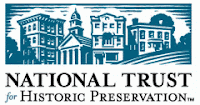 [Source: Cumberland Times-News] -- The National Trust for Historic Preservation is accepting nominations for its 2008 America’s 11 Most Endangered Historic Places list. The list is issued annually to raise awareness of historic sites at risk from neglect, deterioration, lack of maintenance, insufficient funds, inappropriate development, or insensitive public policy.
[Source: Cumberland Times-News] -- The National Trust for Historic Preservation is accepting nominations for its 2008 America’s 11 Most Endangered Historic Places list. The list is issued annually to raise awareness of historic sites at risk from neglect, deterioration, lack of maintenance, insufficient funds, inappropriate development, or insensitive public policy.Among the many sites that have been listed are Historic Neighborhoods of New Orleans; Ellis Island in New York Harbor; the Kennecott Copper Mines in Alaska; Bethlehem Steel Plant in Bethlehem, Pa.; the World Trade Center Vesey Street Survivors’ Staircase; and The Journey Through Hallowed Ground Corridor in Virginia, Maryland and Pennsylvania.
For more information about the application process, click here or call (202) 588-6141. Nominations will be accepted until Jan. 4, 2008. The 2008 list will be announced in May.
Thursday, November 15, 2007
Phoenix buys 945 acres of preserve land
Volunteers needed to keep Phoenix history alive
Four northern Arizona inns share frontier heritage
 [Source: Kelli M. Donley, Arizona Republic] -- Southern Arizona doesn't have the market cornered on historic hotels. If northern Arizona interests you, here are hotels in Prescott, Flagstaff and Winslow where you can have an out-of-the-ordinary experience.
[Source: Kelli M. Donley, Arizona Republic] -- Southern Arizona doesn't have the market cornered on historic hotels. If northern Arizona interests you, here are hotels in Prescott, Flagstaff and Winslow where you can have an out-of-the-ordinary experience.Hassayampa Inn
When President Abraham Lincoln signed a bill creating Arizona Territory in 1863, the Wild West was far from being tamed. The territory was mostly brutal desert, although many saw a golden opportunity to find the American dream. Ranch hands, miners and lumberjacks filled the streets of Prescott seeking work and a new life. More than 60 years later, the owners of the Hassayampa Inn struck gold with their 67-room hotel, which would host Will Rogers, Clark Gable and World War I hero Gen. John J. "Black Jack" Pershing. "Today, our typical weekend guest is from the Valley, escaping the heat and hustle and bustle of the big city for the cool, calm of our little town," says Skip Drinkard, general manager.
Prescott is a big little city, with many festivals and events in Courthouse Square that draw visitors from across the state. "Prescott is known as the Christmas City during the holiday season, and the tree-lighting on the Courthouse Square on the first Saturday in December attracts thousands," Drinkard says. Guests at the Hassayampa (pictured) may encounter another fabled guest: the resident ghost, Faith. As the story goes, Faith was a young bride who was left by her new husband on their honeymoon in 1927. After several days of waiting for him in the honeymoon suite, she hanged herself. Since then, guests and staff have reported seeing a distraught young woman in a pink robe wandering the hotel. The Hassayampa Inn features the Peacock Room restaurant, which also offers banquet services. Weddings in the gazebo are popular; the rooftop terrace, another wedding spot, provides a beautiful view of the city. The inn was added to the National Register of Historic Places in 1979.
Where: 122 E. Gurley St., Prescott. About 100 miles from central Phoenix. Take Interstate 17 north to Arizona 69 (Exit 262), then go northwest to Arizona 89, which turns into Gurley Street. Rates: $129-$235 per night. Details: 928-788-9434 or Hassayampa Inn.
[Note: To read the full article, click here. Photo source: LC Web Design.]
Wednesday, November 14, 2007
Preserving black history in the military, at Fort Huachuca's ‘Colored Officers Club’
 [Source: Randal C. Archibold, New York Times] -- The door to the tumbledown clapboard building, the one with the “Off Limits” sign, creaks open, and Harlan Bradford’s flashlight beam cuts through the shadows inside. Now in the spotlight, bat droppings on the floor. Up above, drop-ceiling railings dangle like stalactites. A stage curtain in tatters hints at the shows, the many shows that once rocked this place, the former Mountain View Colored Officers Club. “You can see and hear them and imagine everyone having a good time,” said Mr. Bradford, a retired Army man himself, glancing around at the exposed walls, the boarded-up windows, the dust. “Lena Horne sang here. Joe Louis did exhibition fights out here. There was nothing like it.” It was, a report for the Army Corps of Engineers said, the only club built expressly for black officers during the days of segregation in the military. Other installations converted buildings for black officers and enlisted men, but the Mountain View club, it said, was the only such club built from the ground up. And now, to the dismay of Mr. Bradford and the community group he leads, the Southwest Association of Buffalo Soldiers, it sits in ghostly tatters.
[Source: Randal C. Archibold, New York Times] -- The door to the tumbledown clapboard building, the one with the “Off Limits” sign, creaks open, and Harlan Bradford’s flashlight beam cuts through the shadows inside. Now in the spotlight, bat droppings on the floor. Up above, drop-ceiling railings dangle like stalactites. A stage curtain in tatters hints at the shows, the many shows that once rocked this place, the former Mountain View Colored Officers Club. “You can see and hear them and imagine everyone having a good time,” said Mr. Bradford, a retired Army man himself, glancing around at the exposed walls, the boarded-up windows, the dust. “Lena Horne sang here. Joe Louis did exhibition fights out here. There was nothing like it.” It was, a report for the Army Corps of Engineers said, the only club built expressly for black officers during the days of segregation in the military. Other installations converted buildings for black officers and enlisted men, but the Mountain View club, it said, was the only such club built from the ground up. And now, to the dismay of Mr. Bradford and the community group he leads, the Southwest Association of Buffalo Soldiers, it sits in ghostly tatters. [Note: To read the full article, click here. Photo source: Rick Scibelli Jr., New York Times.]
Monti's project redesign wins Tempe Historic Commission support
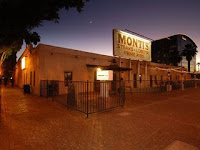 [Source: Katie Nelson, Arizona Republic] -- Tempe's Historic Preservation Commission whole-heartedly backed a redevelopment plan for the historic Hayden home-turned-Monti's La Casa Vieja steakhouse Thursday night, after vehemently trashing previous designs and sending the developer "back to the drawing board" only weeks before. "The new plan not only recognizes, but further honors this historic building," said Ann Patterson, who was one of the commission's most outspoken opponents of the previous version.
[Source: Katie Nelson, Arizona Republic] -- Tempe's Historic Preservation Commission whole-heartedly backed a redevelopment plan for the historic Hayden home-turned-Monti's La Casa Vieja steakhouse Thursday night, after vehemently trashing previous designs and sending the developer "back to the drawing board" only weeks before. "The new plan not only recognizes, but further honors this historic building," said Ann Patterson, who was one of the commission's most outspoken opponents of the previous version.Tony Wall,an Ohio transplant who is developing the University Square site off University Drive and Forest Avenue, is also seeking to develop the historic Monti's site into a pair of high rises. The steak restaurant sits inside the Hayden house, a structure built by Tempe's Anglo founder, Charles Trumbull Hayden. The adobe structure is now regarded as one of the Valley's oldest buildings. The first versions of Wall's architectural drawings put one of the proposed multi-use towers on top of the Hayden House. This concept displeased the commission, which is charged with protecting Tempe's historic sites. The newest rendition puts the towers just south of the old restaurant. Now that the "One Hundred Mill Avenue" project has the blessing of the preservation commission, the conceptual plan will undergo scrutiny by the Development Review Commission and the City Council in the coming weeks.
[Note: To read the full article, click here. Photo source: Monti's.]
Public hears preservation plans for Oro Valley’s historic ranch
 [Source: Patrick McNamara, Explorer] -- Members of the public came out to voice their opinions and concerns about historic preservation efforts at Steam Pump Ranch, Oro Valley’s territorial-era settlement. Representatives from the architectural firm Poster Frost were on hand to explain three preservation scenarios for the ranch house and 15-acre property, which dates to the 1870s. The town contracted Poster Frost, which specializes in historic preservation and renovations. The firm will seek to implement a plan for the site that the town-appointed Steam Pump Ranch Task Force develops with the public’s input. One possibility for the site, which the task force has labeled “Eras of Oro Valley History,” would include protohistory and Native American displays, Arizona territorial representations, statehood and town incorporation exhibits.
[Source: Patrick McNamara, Explorer] -- Members of the public came out to voice their opinions and concerns about historic preservation efforts at Steam Pump Ranch, Oro Valley’s territorial-era settlement. Representatives from the architectural firm Poster Frost were on hand to explain three preservation scenarios for the ranch house and 15-acre property, which dates to the 1870s. The town contracted Poster Frost, which specializes in historic preservation and renovations. The firm will seek to implement a plan for the site that the town-appointed Steam Pump Ranch Task Force develops with the public’s input. One possibility for the site, which the task force has labeled “Eras of Oro Valley History,” would include protohistory and Native American displays, Arizona territorial representations, statehood and town incorporation exhibits. Another option for the site, dubbed “A Day in the Life,” consists of recreations circa 1944. The year was chosen because researchers believe buildings from most prior eras of the property were in place then. A third choice includes major elements from two dominant periods in the history of Steam Pump Ranch: the founding of the property in the 19th Century and the post-1933 era when the Procter family bought the ranch. A dividing line would separate original Pusch-era structures from the buildings added by the Procters, including a chicken coop the family used to raise poultry and produce eggs. All of the possibilities include variations on a visitor or orientation center that would inform visitors of the property’s history. The ultimate goal of the three options is to have the property registered with the U.S. Department of Interior’s National Registry of Historic Places. Public input on the presentations focused mainly on concerns that town officials find ways to make sure the site won’t become a drain on taxpayers. How the site will remain solvent hasn’t been determined, but a likely scenario involves renting out the space, or portions of it, for private functions like weddings and parties. The next Steam Pump Ranch public meeting is set for Jan. 10. For more information, go to the Oro Valley’s Planning Department, or call Town Planner Pamela Pelletier at 229-4813. [Photo source: Town of Oro Valley.]
Monti’s Restaurant in Tempe will have neighboring towers
 [Source: Garin Groff, Tribune] -- Michael Monti has made peace with historic preservationists who blasted his initial plan to build a high-rise tower above the Valley’s oldest building. Tempe’s Historic Preservation Commission signed off on his plans Thursday to build two towers next to Monti’s La Casa Vieja, just weeks after rejecting an earlier proposal. Monti’s first plan included a pair of towers, one of which would have stood on piers that surrounded the adobe structure built in 1871. Critics said the plan shrouded the building and could get it kicked off state and national historic registries.
[Source: Garin Groff, Tribune] -- Michael Monti has made peace with historic preservationists who blasted his initial plan to build a high-rise tower above the Valley’s oldest building. Tempe’s Historic Preservation Commission signed off on his plans Thursday to build two towers next to Monti’s La Casa Vieja, just weeks after rejecting an earlier proposal. Monti’s first plan included a pair of towers, one of which would have stood on piers that surrounded the adobe structure built in 1871. Critics said the plan shrouded the building and could get it kicked off state and national historic registries.The new plan leaves the oldest part of the building as it stands today, and won compliments from those who opposed the original plan. The building is perhaps the Valley’s most significant historic structure. It was built by Tempe founder Charles Trumbull Hayden, whose son Carl was born in the house. Carl Hayden served in Congress for 57 years and has been called Arizona’s most important person. Monti plans to tear down newer additions to the restaurant and keep the oldest 11,000 square feet of the structure. He intends to sell the property to developer 3W Cos. but continue to operate the restaurant that his father bought in the 1950s. The new buildings will include shops, condos and a hotel. The hotel’s name will include the name Hayden. [Image source: DFD CornoyerHedrick, the same architectural firm that proposed the design concept for condos in and atop the Sun Mercantile Building in downtown Phoenix.]
New $1.3M Tempe home splits neighbors
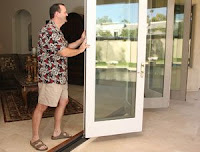 [Source: Tony Natale, Tribune] -- A new, $1.3 million house in an old Tempe neighborhood near downtown where most homes are valued between $250,000 and $350,000 is both a blessing and a curse to local residents. However, for its builder, Jimmy Evans (pictured), 40, the house is a gamble that Evans hopes will result in both a bottom-line profit and the start of a building trend he can profitably repeat in other older Tempe communities. After Evans sought and won approval from Tempe to build the comparatively expensive home, residents of the area — with Evans’ encouragement — sought and won approval from the city and the Historic Preservation Commission to be declared an official historic district. In historic districts, builders are restricted from erecting homes, condos, apartments or other dwellings that do not meet historical or cultural requirements. For example, they can now build only one-story houses that architecturally blend with the surrounding ones.
[Source: Tony Natale, Tribune] -- A new, $1.3 million house in an old Tempe neighborhood near downtown where most homes are valued between $250,000 and $350,000 is both a blessing and a curse to local residents. However, for its builder, Jimmy Evans (pictured), 40, the house is a gamble that Evans hopes will result in both a bottom-line profit and the start of a building trend he can profitably repeat in other older Tempe communities. After Evans sought and won approval from Tempe to build the comparatively expensive home, residents of the area — with Evans’ encouragement — sought and won approval from the city and the Historic Preservation Commission to be declared an official historic district. In historic districts, builders are restricted from erecting homes, condos, apartments or other dwellings that do not meet historical or cultural requirements. For example, they can now build only one-story houses that architecturally blend with the surrounding ones. Today, Evans’ new one-story house stands at 610 W. Third St. and is among 20 others along a cul-de-sac at Third and Roosevelt streets. It is also the newest home in the newly created Roosevelt Addition Historic District and the only one bearing a for sale sign. “I pushed the movement toward establishing an historic district because, like the people who live in the neighborhood, I, too, didn’t want developers to come in and build condos or high-rises,” said Evans, owner of J Evans Construction, who lives with his wife and two children in Ahwatukee Foothills. Not everybody in the neighborhood agrees. “It’s not the kind of home I think should have been built here,” said Mike Wood, who lives at 624 W. Third St. “This is an old neighborhood with old homes, and I think the new home looks like a giant 'McMansion’ that just plopped down out of the sky.” Wood admitted that until the home was constructed, neighbors were delaying any action toward seeking historic identification. He agreed that establishing a historic district was beneficial toward restricting developers from building high-rises.
[Note: To read the full article, click here. Photo source: Bettina Hansen, Tribune.]
Dec. 3 deadline for proposals to move historic/vintage Evans Churchill properties
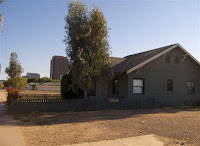 The City of Phoenix, Arizona seeks proposals from persons or entities with the financial and technical capability to acquire, relocate, and renovate four residential buildings within an area bounded by 4th, 6th, Pierce, and Garfield Streets. Proposals for structure demolition and salvage will not be considered. Destination sites for the relocated structures must be in the City of Phoenix.
The City of Phoenix, Arizona seeks proposals from persons or entities with the financial and technical capability to acquire, relocate, and renovate four residential buildings within an area bounded by 4th, 6th, Pierce, and Garfield Streets. Proposals for structure demolition and salvage will not be considered. Destination sites for the relocated structures must be in the City of Phoenix.Information packets may be obtained beginning Monday October 8, 2007. An electronic version of the packet is available on the City of Phoenix Downtown Development Office website. Or, click here for materials.
The deadline for proposals is Monday December 3, 2007 at Noon. For further information, contact Donna Stevens, Program Manager, at 602-495-0376.
Tuesday, November 13, 2007
Teachers encouraged to design social studies lesson plans using historic places
 The Arizona Preservation Foundation is proud to announce the 1st Annual Statewide Contest for teachers to create lesson plans based on Arizona national, state, and local historic places that adheres to Arizona State Social Studies Standards. Contest rules:
The Arizona Preservation Foundation is proud to announce the 1st Annual Statewide Contest for teachers to create lesson plans based on Arizona national, state, and local historic places that adheres to Arizona State Social Studies Standards. Contest rules:- Use Teaching with Historic Places (TwHP) format.
- Submit three copies with cover sheet (name, grade(s) taught, school name, address, and e-mail) with no identification on lesson.
- Send to: Arizona Preservation Foundation, P.O. Box 13492, Phoenix, AZ 85002, ATTN: Centennial Lesson Plan Contest.
- Postmark no later than April 1, 2008.
- For problems, questions, etc., contact Donna Reiner, PhD, contest chair.
- 1st place winner will receive $250, 2nd place $200, 3rd place $150.
- Winners announced at the 6th Annual Arizona Statewide Historic Preservation Conference, June 11-13, 2008 in Rio Rico, AZ.
Governor seeks volunteers to serve on state boards and commissions
 Governor Janet Napolitano invites you to apply to serve on one of the State of Arizona's Boards and Commissions. Openings on two history-related bodies exist:
Governor Janet Napolitano invites you to apply to serve on one of the State of Arizona's Boards and Commissions. Openings on two history-related bodies exist:As of 9/1/2007, four vacancies on the Archaeology Advisory Commission. Each member shall have a demonstrated interest or expertise in one or more of the fields of prehistory archaeology, historic archaeology, anthropology, ethnology, tourism, public education, planning, or economic development.
As of 7/21/2006, one vacancy on the Parkways and Historic and Scenic Roads Advisory Committee.
Take a peek at past Arizona Highways Television segments
Propose a session for the 2008 National Preservation Conference
The National Trust uses an on-line session proposal submission system, which will make your submission experience easy, fun, and efficient. Click the links in the navigation bar above to access the system. To print the instructions on developing, submitting, and managing Education Sessions or Field Sessions, click below:
Important dates to remember for the submission process are:
- Friday, January 11 ~ Proposal submission deadline
- February ~ National Trust reviews, refines and/or combines session proposals
- Thursday, March 1 ~ Affinity event application deadline
- Week of March 10 ~ National Trust notifies applicants of acceptance or rejection of proposal
- March 10-18 ~ National Trust revises session description for inclusion in Preliminary Program
- Monday, April 7 ~ Session managers receive budget and speaker paperwork
- Friday, April 25 ~ Session budget and final speaker information due
- Monday, June 2 ~ National Trust mails Preliminary Program to session manager, moderator, and speakers with taping authorization and audio-visual equipment request forms
- Wednesday, July 30 ~ Recording authorization forms due
- October 21-25 ~ National Preservation Conference 2008
- Monday, December 1 ~ Expense reimbursement requests due
Questions? Please contact conference@nthp.org. Begin the online submission process for Education Sessions and Poster Sessions.
Monday, November 12, 2007
Henry Wickenburg to stay put
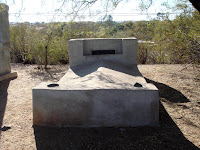
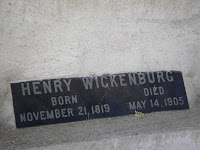 [Source: Janet DelTufo, Wickenburg Sun] -- Town Founding Father Henry Wickenburg will not be moved from his current gravesite location and will remain on a hill off of Howard Court with other former town dignitaries. A decision regarding the location of Wickenburg’s grave, which has been a source of discussion for several months, was finally made Monday night (Nov. 5). The original plan to move his tomb, along with the tomb of at least four other former Wickenburg residents, was rescinded from an earlier council decision. “I visited the gravesite, and I had second thoughts,” said Mayor Ron Badowski. “The gravesites are in good shape, and this is not a matter of state dollars, but leaving him where he should be. I thought at first we should move the tombs, and I now apologize for leaning that way. I would like to leave Henry where he is right now.”
[Source: Janet DelTufo, Wickenburg Sun] -- Town Founding Father Henry Wickenburg will not be moved from his current gravesite location and will remain on a hill off of Howard Court with other former town dignitaries. A decision regarding the location of Wickenburg’s grave, which has been a source of discussion for several months, was finally made Monday night (Nov. 5). The original plan to move his tomb, along with the tomb of at least four other former Wickenburg residents, was rescinded from an earlier council decision. “I visited the gravesite, and I had second thoughts,” said Mayor Ron Badowski. “The gravesites are in good shape, and this is not a matter of state dollars, but leaving him where he should be. I thought at first we should move the tombs, and I now apologize for leaning that way. I would like to leave Henry where he is right now.”No one in the audience or any other council member voiced an opposing view. Everyone seemed to agree with the mayor’s sentiments. Resident Paul Woley spoke first to the council, shedding new light on the situation. He informed the audience that Henry Cowell, who is in a larger tomb with his wife Lydia next to Wickenburg, was the town’s first-ever mayor. “Wickenburg is sort of known as an Old West town, and who we were and what we did in the past defines us,” Woley said. “It is important not to ignore our history, and moving Henry Wickenburg is ignoring history. You have to realize that any change we make changes what we were in the past. Leaving Henry where he is gives us an opportunity to tell a story, and I encourage you to think about keeping that history alive and keeping the grave where it is now.”
Businessman Bill Green also spoke on behalf of not moving the tombs and to allow the former residents to rest in peace. “Henry has been there for 100 years or more, and the gravesites are in very nice shape,” Green said. “I would, however, be opposed to spending any tax money to improve the walkway. I even think a wheelchair can be pushed up the hill (with the existing walkway).”
Green also said there should be no issue with encroachment in order to get to the gravesite because individuals have been using the walkway for 100 years. However, Cindy Thrasher of the Wickenburg Historical Preservation Society said that the property owner who is being encroached upon wrote a letter to the town several years ago making note of the issue. “I think the town should purchase the property in question,” Thrasher said. “We are going to have problems whether we move the tombs or leave them where they are, and we will have to eventually address these problems.”
Thrasher suggested installing a fence around the area and adding directional signage to the gravesite. “If we leave the tombs where they are, improvements need to be made,” Thrasher said. “Either site is appropriate, but if we leave the graves where they are, we will need to make some decisions as to how we are going to improve the area.” Thrasher will again need to go in front of the council to address the situation, since there was no resolution during the meeting as to how the improvements would be addressed. [Photo source: Frank Barrios and Reba Grandrud]
Sunday, November 11, 2007
Irreplaceable parts of Tucson destroyed
A demolition crew hired by the city went to the park sometime during the last month. It was supposed to take down 10 buildings that were part of the observatory complex. Instead, the crew took down 11 buildings. Marty McCune, the city's historic preservation officer, said in a Star story on Tuesday: "It's always a loss when you lose historic resources. It was simply a miscommunication, a human mistake." In the future, maybe such errors can be avoided by wrapping some police crime scene tape around the building and planting a sign out front that says, "Do not destroy." Tucson has a reputation as a community that values its heritage and its history. We need to do more to live up to that reputation. Last February, a similar "human error" resulted in the destruction of a stand of giant saguaros for a new housing development near West Speedway and North Silverbell Road. [Note: To read the full article, click here.]
Plans back on track to restore Mesa's historic Alston house
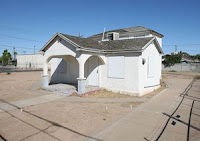 [Source: Lindsay Butler, East Valley Tribune] -- Plans to restore the home of Mesa’s first black doctor have reawakened after being dormant for months. The Alston House, at the corner of Fifth Street and Pima near Washington Park, was built in the 1920s and was home to Dr. Lucius Alston who used it to treat patients from the community. The house has particular significance to the black and Hispanic communities in Mesa, and it will house offices for the Mesa Martin Luther King Jr. Celebration Committee and the Mesa Association of Hispanic Citizens. “It’s going to help us out tremendously to have a place to meet, something stable we can call our own,” said Everette Woods, MLK committee vice president. “And it will be a place for the community to look out and say, ‘This is ours.’ ” Mesa’s Historic Preservation Office has been working on restoring the house for years, but the progress slowed this summer when preservation officer Stephanie Bruning took a job out of state.
[Source: Lindsay Butler, East Valley Tribune] -- Plans to restore the home of Mesa’s first black doctor have reawakened after being dormant for months. The Alston House, at the corner of Fifth Street and Pima near Washington Park, was built in the 1920s and was home to Dr. Lucius Alston who used it to treat patients from the community. The house has particular significance to the black and Hispanic communities in Mesa, and it will house offices for the Mesa Martin Luther King Jr. Celebration Committee and the Mesa Association of Hispanic Citizens. “It’s going to help us out tremendously to have a place to meet, something stable we can call our own,” said Everette Woods, MLK committee vice president. “And it will be a place for the community to look out and say, ‘This is ours.’ ” Mesa’s Historic Preservation Office has been working on restoring the house for years, but the progress slowed this summer when preservation officer Stephanie Bruning took a job out of state.[Note: To read the full article, click here. Photo source: Lisa Olson, East Valley Tribune.]
Temple of doom
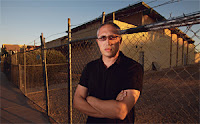 [Source: Sarah Fenske, Phoenix New Times] -- In a city where everybody is nice, where conference tables in fancy law firms take the place of the proverbial smoke-filled room, Michael Levine is something else. He is not particularly nice. Nor is he a law firm kind of guy, or even a conference table kind of guy. ("Michael doesn't do well in meetings," one of his friends tells me.) He's abrasive and outspoken, and if you don't like it, he just might just lob an F-bomb at you in his New Yawk accent. So I practically fell off my chair last week when Levine told me that he'd hired a lawyer for his latest crusade. And not just any lawyer. The buzz around town is he's got somebody at Lewis and Roca, the bluest of blue-chip firms. In a case like the one I'm about to describe, you don't hire Lewis and Roca to sue. You hire them to finesse the inside game. Even Levine is a little sheepish about it. "Hey, I usually go in with my guns blazing and let the dust settle later," he tells me. "But now I have an attorney."
[Source: Sarah Fenske, Phoenix New Times] -- In a city where everybody is nice, where conference tables in fancy law firms take the place of the proverbial smoke-filled room, Michael Levine is something else. He is not particularly nice. Nor is he a law firm kind of guy, or even a conference table kind of guy. ("Michael doesn't do well in meetings," one of his friends tells me.) He's abrasive and outspoken, and if you don't like it, he just might just lob an F-bomb at you in his New Yawk accent. So I practically fell off my chair last week when Levine told me that he'd hired a lawyer for his latest crusade. And not just any lawyer. The buzz around town is he's got somebody at Lewis and Roca, the bluest of blue-chip firms. In a case like the one I'm about to describe, you don't hire Lewis and Roca to sue. You hire them to finesse the inside game. Even Levine is a little sheepish about it. "Hey, I usually go in with my guns blazing and let the dust settle later," he tells me. "But now I have an attorney."So here's the story: Levine is fighting to save an old Jewish temple in downtown Phoenix. Here's the catch: Though he's a developer and preservationist with plenty of holdings downtown, Levine doesn't actually own the building in question. The building's owner, the nonprofit Black Theatre Troupe, is in escrow with someone else — developers likely interested in building a high-rise on the site, at Portland Street just east of Third Street. And until the deal closes in three months, the theater troupe won't even tell Levine its buyer's name. No wonder Michael Levine has resorted to the trappings of respectability. This fight is not going to be easy.
[Note: To read the full article, click here. Photo source: Tony Blei, New Times.]
A toast to saving a bit of Phoenix's history
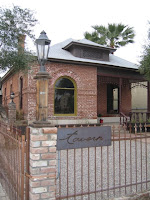 [Source: Scott Craven, Arizona Republic] -- Phoenix isn't known for cherishing history. Older homes, offices and other buildings routinely have been torn down over the decades to make way for the new and improved, if not as distinctive. Which makes the survival of 816 N. Third St. all the more remarkable. The modest home hardly seems the survivor type, what with its red bricks flecked with paint layered on over the years, and its location just enough off the beaten path to make it difficult to notice. Matt Pool never looked twice at the single-story structure, though he would drive past it every day on his way to work. But what Pool did see one day two years ago was the "For Lease" sign suddenly posted in the front yard.
[Source: Scott Craven, Arizona Republic] -- Phoenix isn't known for cherishing history. Older homes, offices and other buildings routinely have been torn down over the decades to make way for the new and improved, if not as distinctive. Which makes the survival of 816 N. Third St. all the more remarkable. The modest home hardly seems the survivor type, what with its red bricks flecked with paint layered on over the years, and its location just enough off the beaten path to make it difficult to notice. Matt Pool never looked twice at the single-story structure, though he would drive past it every day on his way to work. But what Pool did see one day two years ago was the "For Lease" sign suddenly posted in the front yard. Pool, looking for a space in which to open a neighborhood tavern, had unknowingly stumbled upon the Farish House, built in 1900 and one of the handful of homes that somehow had escaped the city's penchant for destroying the old to make room for the new. Charmed by the home's historical quaintness, Pool - owner of the popular downtown restaurant Matt's Big Breakfast and a former bartender - soon would sign a lease. The result was Roosevelt Tavern, making the home perhaps more popular now than it had been in its previous 107 years. Few of those sipping an ice-cold beer fresh from the Roosevelt's super-cooled taps realize they are sitting in one of the few downtown homes that have survived for more than a century; intact, and in the same location.
[Note: To read the full article, click here. Photo source: Roosevelt Row.]
Tempe pub demolished to make way for hotel
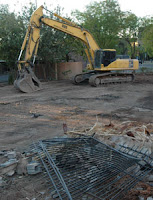 [Source: Jeff Mitchell, ASU Web Devil] -- A towering yellow excavator stood over concrete rubble, steel cables and topsoil Thursday where the Bandersnatch Brew Pub once stood. "It's a sad day," said Vic Linoff, owner of Those Were The Days! Bookstore at 516 S. Mill Ave. for decades. "Bandersnatch was an icon for downtown." The pub is making room for an 11-story Residence Inn by Marriott, said Darcy Gray, senior project manager for Layton Construction, the firm overseeing the demolition. Bandersnatch, which sat at Forest Avenue and Fifth Street, opened in the 1970s and was a unique pub, Linoff said. It had an outdoor volleyball court, microbrew tanks and grills where customers could make their own burgers, he said. Interior design senior Meredith Nunn said older buildings being demolished for new development was a recent pattern in Tempe.
[Source: Jeff Mitchell, ASU Web Devil] -- A towering yellow excavator stood over concrete rubble, steel cables and topsoil Thursday where the Bandersnatch Brew Pub once stood. "It's a sad day," said Vic Linoff, owner of Those Were The Days! Bookstore at 516 S. Mill Ave. for decades. "Bandersnatch was an icon for downtown." The pub is making room for an 11-story Residence Inn by Marriott, said Darcy Gray, senior project manager for Layton Construction, the firm overseeing the demolition. Bandersnatch, which sat at Forest Avenue and Fifth Street, opened in the 1970s and was a unique pub, Linoff said. It had an outdoor volleyball court, microbrew tanks and grills where customers could make their own burgers, he said. Interior design senior Meredith Nunn said older buildings being demolished for new development was a recent pattern in Tempe. [Note: To read the full article, click here. Photo source: Chris Atwood, State Press.]
Thursday, November 08, 2007
NAU starts Heritage Management Journal
Heritage Management will include peer-reviewed research on policy, legislation, ethics, and methods in heritage management and will showcase exemplary projects and models of public interpretation and interaction. A peer-reviewed Forum section presents position statements and responses on key current issues. The journal also includes reviews of books, web pages, exhibits, and resources in various media.
Submission Guidelines: Heritage Management welcomes submission of original manuscripts of no more than 30 double spaced pages that focus on management of the world’s heritage resources. All manuscripts are subject to anonymous peer review by knowledgeable scholars and professional practitioners and, if accepted, may be subject to revision. Materials submitted to HMJ should not be under consideration by other publishers, nor should they be previously published in any form. Submissions should include an original manuscript sent via email in MS Word or RTF format. Manuscripts should be submitted with low resolution illustrations that can be easily be transmitted via email. They should include a title page that has the article title, names, and full contact information of all authors; and an abstract of no more than 200 words.
Manuscript style generally should conform to Society for American Archaeology Style Guide. Non-conforming manuscripts will be returned to the author(s) for revision. Additional details concerning preparation of final manuscripts accepted for publication can be located at Left Coast Press or from the editors. For other questions and correspondence, contact one of the co-editors, Kelley Hays-Gilpin and George Gumerman IV at Northern Arizona University
The journal will be published semi-annually in March and September, 288 pages per volume, starting in March 2008. One year subscription prices: Individuals: $40; Heritage Orgs: $89 (paper), $140 (paper and electronic); Institutions: $149 (paper), $249 (paper and electronic).
Old Arizona resides within these hotels
To be considered a historic hotel by the National Trust for Historic Preservation, hotels must be in a building that is at least 50 years old, recognized locally for their historical significance, or listed on or eligible for the National Register of Historic Places.
Hotel Gadsden. The Gadsden is easy to find in downtown Douglas: A large sign stands tall atop the historic building in this border town. The quiet street draws little traffic and seems like a set from a 1950s television show. The lobby is impressive. Your eye is drawn past marble columns and up the white Italian marble staircase to a series of stained-glass windows on the second floor. Light pours through the desert scenes depicted in the Tiffany glass, casting a rainbow of colors on the lobby floor.
Pancho Villa once rode a horse up those very stairs, which were among the few things to survive a sweeping fire that nearly destroyed the Gadsden in 1929. The hotel opened in 1907 and is named after the Gadsden Purchase of land that is now part of Arizona and New Mexico. Famous guests have included movie stars - much of the 1994 movie Terminal Velocity featuring Charlie Sheen was filmed at the hotel - and dignitaries, including Eleanor Roosevelt. The hotel has 130 rooms, a coffee shop, dining rooms and a beauty salon, among other amenities. In addition to heading across the border for a day trip to Mexico, Gadsden guests often visit the Cochise Stronghold, an Apache hideout in the Dragoon Mountains; Kartchner Caverns; and the ghost towns of Gleeson and Paradise.
Some people come here to visit doctors and dentists in nearby Agua Prieta, Sonora, says hotel manager Robin Brekhus. "Others come to escape the heat. It's a great place to stay for a weekend to visit the Wonderland of Rocks (in Chiricahua National Monument) and go hiking or have a picnic, or to visit nearby places like Rodeo, N.M., or Bisbee or Tombstone." The hotel was listed on the National Register of Historic Places in 1976, in part because of its manual telephone switchboard, installed in 1929. The switchboard was the first in the state and can be seen behind the front desk.
Where: 1046 G Ave. Douglas is about 230 miles southeast of central Phoenix. Take Interstate 10 east through Tucson to Exit 303 at Benson. Go south on Arizona 80 past Tombstone and Bisbee to Douglas, where the state route turns into G Avenue. Rates: $60-$150 per night. Details: 520-364-4481 or www.hotelgadsden.com.
Copper Queen Hotel. Bisbee is a quaint town often overlooked by Phoenicians seeking cooler climates. Although plenty of residents of this former mining town are happy that their rolling hills haven't turned into a regular weekend retreat like Payson or Pinetop-Lakeside, cooler weather, antiques and curio shops also are found here. And a great hotel. "I moved here for the small-town life I'd been looking for in Tucson," says Adam Lamb, operating manager at the Copper Queen, tipping back his large straw cowboy hat. "You can walk down the main street and have people look you in the eye and say hello, or invite you in for a beer. Plus, we run an average of 10 to 15 degrees cooler than Tucson and 15 to 20 degrees cooler than Phoenix."
Phelps Dodge began building the Copper Queen in 1898 and finished it four years later, providing the perfect atmosphere in which to entertain potential investors. With a few significant changes over the years, the hotel now has 52 rooms, no two alike. The five-story building has four levels of rooms, with the fifth floor housing the mechanics of the elevator, installed in the 1940s. "The hotel went on the National Register of Historic Places in 1980," Lamb says. "The hotel is Arizona's longest continuously operating hotel; her doors have never been closed in all 106 years."
Many visitors come to see the hotel's rumored ghosts; the Copper Queen was featured on the television show Ghost Hunters. The most popular "haunted" request is to stay in the Julia Lowell room. Lowell was a prostitute who reportedly took her life at the hotel after being left brokenhearted. "I do believe it is haunted," Lamb says. "I've seen a confused little girl several times." A ghost register at the front desk features vivid stories written by guests. Lamb says the staff is working to have the stories published.
It is easy to fall in love with the Copper Queen. The rooms are clean, and the hotel grounds are tidy. Breakfast is served on the patio under hanging baskets of colorful flowers, guests can take in panoramic views of the surrounding hills, and even the bowl of root-beer candies on the front desk is welcoming. Guests come to enjoy the Bisbee Pride festival in June, blues festival in September and wine festival in October. Fuel your day with a cup of Eureka, espresso and coffee at the Bisbee Coffee Co., across the street from the hotel. "There is a lot of history here in this little old mining town at the bottom of the canyon," Lamb says.
Where: 11 Howell Ave. Bisbee is about 200 miles southeast of central Phoenix. Take Interstate 10 east through Tucson to Exit 303 at Benson. Go south on Arizona 80 past Tombstone to Bisbee. Go left at the Old Bisbee exit, then left on Naco Road, right on Brewery Avenue and immediately left on Howell Avenue. Rates: $122-$200 per night. Details: 520-432-2216 or www.copperqueen.com.
Hotel Congress. Maneuvering through the construction and one-way streets in downtown Tucson can be tricky, but the reward is worth the hassle. The Hotel Congress, built in 1919, is where John Dillinger and members of his gang hid out before they moved to a nearby apartment, where police arrested them in 1934. Today, the Congress is a hip alternative to a chain hotel. The Cup Cafe boasts a mean cup of joe and an impressive display of baked goods, and the floor is made entirely of copper pennies. The sounds of jazz pour out of Club Congress, just off the lobby. The front desk sits aptly between the two worlds: caffeine on one side and alcohol on the other. Similarly, the hotel seems to meld rich history with a contemporary vibe. "The Hotel Congress is in the heart of downtown, which includes an amazing arts and entertainment district, including the Rialto Theatre, the Fox Theatre and Tucson Children's Museum," says Todd Hanley, general manager.
Rooms are clean and vintage; they have radios and reading lamps but no televisions. The decor varies, with the most noticeable being the garish paint by artist Larry Boyce. He described his style as "Southwest Deco" when he painted the lobby and staircase in 1989. The orange, green and purple jump out from the walls, which also hold framed pieces for sale from local artists. The old-fashioned telephone booths on the lobby floor top the urban feel with an antique icing. Pets are welcome, and the hotel has Wi-Fi service. The Hotel Congress was added to the National Register of Historic Places in 2003.
Where: 311 E. Congress Ave. Tucson is about 110 miles from central Phoenix. Take Interstate 10 east to Speedway Boulevard (Exit 257), go left on Speedway, right on Fourth Avenue, then right on Congress Avenue. Rates: $69-$119 per night September through May. Rates are lower in summer. Details: 520-622-8848 or www.hotelcongress.com.
Phoenix's "mushroom" bank and grounds spared...for now
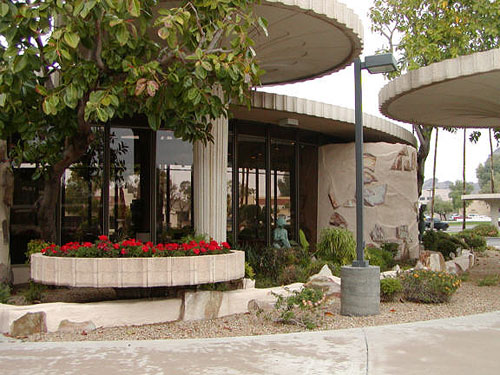 [Source: Michael Clancy, Arizona Republic] -- One redevelopment project at a controversial Arcadia neighborhood intersection got the green light, but two others were curbed by decisions of the Phoenix City Council on Wednesday evening. The council decisions end for now a long and argumentative process for redevelopment of three corners at Camelback Road and 44th Street.
[Source: Michael Clancy, Arizona Republic] -- One redevelopment project at a controversial Arcadia neighborhood intersection got the green light, but two others were curbed by decisions of the Phoenix City Council on Wednesday evening. The council decisions end for now a long and argumentative process for redevelopment of three corners at Camelback Road and 44th Street.The council approved the project proposed for the southwest corner, where Grace Communities wants to erect nine buildings topping out at four stories that would house 175,000 square feet of retail and office, as well as 42 condominiums and a 125-room hotel. The project will wrap around the Londen Center, a four-story building, and replace an aging strip mall, two office buildings and a handful of single family homes.
On the southeast corner, the council denied a proposal from Opus Corp. and Chase Bank for a three-story building with retail on the ground floor and condos above, on vacant land east of the bank building, widely recognized for its unusual design. But failure to win an agreement to preserve the bank building for longer than 10 years led to the denial.
On the northwest corner, M3 Companies withdrew its proposal for the CamelSquare site after the council rejected a request for more time that M3 said it needed to redesign the project in conformance with the Phoenix Planning Commission's recommendation a month ago that the buildings go no higher than 70 feet.
New proposals can be filed with the city after a year from the original filing. [Note: For first mention of this brewing issue, click here.]
Historic preservation discussed at recent Arizona Town Hall on land use
- Include enactment of comprehensive State Land Department reform;
- Promote effective intergovernmental collaboration and cooperation;
- Balance the human, natural, and cultural resources;
- Embrace conservation opportunities; and
- Recognize the responsibility of all citizens to work towards a prosperous, livable, sustainable, and economically responsible future.
The participants of the 91st Arizona Town Hall, drawn from across the state, met for three days of thoughtful discussion and deliberations, inspired by the majesty of the Grand Canyon as a backdrop. These citizens believe that the time has come to face the challenges of future growth by making hard land use choices for the 21st century. This Town Hall addressed population growth; the balance of responsibility for land use planning and regulation among local, regional, tribal, federal, and state governments; and the effectiveness of collaboration among tribal and non-tribal communities. Participants examined the interface of land-use planning with transportation, education, water, energy, and state trust land issues. They debated the best approaches to creating livable communities and considered the roles of financing and incentives in directing change.
The results of these discussions are included in this report (in PDF format). While not all Town Hall participants agree with each of the conclusions and recommendations, the report reflects the overall consensus achieved at the 91st Arizona Town Hall.